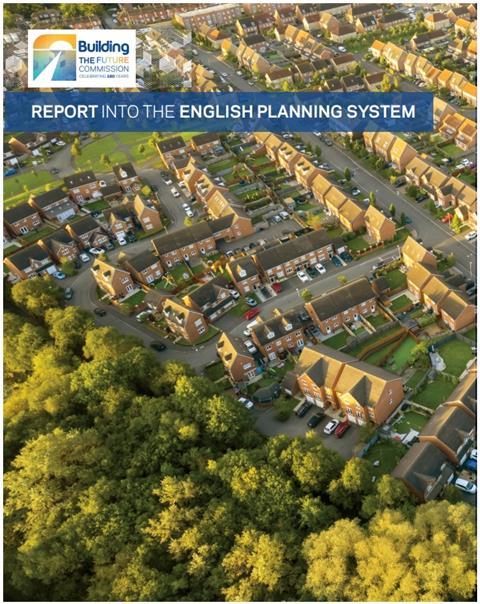The Building the Future Commission has spent several months analysing the English planning system and working out how to resolve the issues that prevent planners, developers and builders from delivering the homes the country so desperately needs, Joey Gardiner reports

When Redrow founder Steve Morgan accused the government this year of acting like it “wants to destroy the industry”, it was pretty clear what he was mainly taking aim at: the English planning system. Morgan was just one of a myriad of housebuilders and developers to complain in recent months about the operation of a system made even worse by Michael Gove’s December 2022 plans to water down local housing targets.

In response to mounting evidence of the dire state of the planning system – and the extent to which it is now holding back delivery of new homes – the Building the Future Commission decided to launch a review of the system. Doing so proved an enormous challenge, but it also unearthed a surprising degree of consensus, and prompted some far-reaching recommendations.
>> Also read: Steve Morgan interview: it’s like the government wants to destroy the industry
Finding evidence that the system was on its knees was not hard. After all, Morgan’s comments had come after current Redrow boss Matthew Pratt had already claimed that the “unacceptably slow” system had hit its “lowest point for a number of years”. This year, Taylor Wimpey chief executive Jennie Daly said planning delays were the worst she had known them “for 30 years”.
Just 15% of major decisions are now approved within the requisite 13 weeks, while the number of homes being granted permission annually has fallen for four consecutive years

The hard numbers backed up the anecdotes: official data shows that just 15% of major decisions are now approved within the requisite 13 weeks, while the number of homes being granted permission annually has fallen for four consecutive years, and last year was almost a fifth below the 2017 peak. Consultant Lichfields recently calculated that it now takes an average of a year to secure a permission – four times the length it did 30 years ago.
But it is not just applicants that are struggling with the system. Those operating it appear to be at the end of their tether and struggling to provide a proper service.
Public funding for planning departments has dropped by nearly 60% per capita in a decade, suffering the deepest cuts of any council service, while a quarter of all qualified planners have moved from the public to the private sector. Funding cuts mean that those areas which are not fee earning, such as plan-making are hit particularly hard: on current trends just 22% of local authorities are expected to have a vital local plan in place by 2025.
Given all this, and the pressing need of the housing crisis, the Building the Future Commission decided to give its review of the functioning of the planning system a specific remit around housing supply.
With the complexity of the system, how much change it has been subject to in recent years, and how many reviews and studies have already been conducted – including the Raynsford Review and Letwin Review in recent years – the key question was how to ensure that our work was effective and genuinely contributed to the debate.
Part of this was to set its limits. The review considered only the operation of the English planning system, given that planning is a devolved function, with the UK nations having their own rules – the planning “crisis” identified above is one that relates to England; other countries would have needed their own wholly separate reviews.
English planning policy may, according to a crude view of things, be encapsulated in a single 76-page document (the NPPF), but it is also guided by 57 separate lengthy planning practice guidance documents, multiple national infrastructure planning statements, myriad planning acts going back to 1947, hundreds of individual local plans and policies, and over 75 years of detailed case law. Simply purporting to understand, let alone review this, without getting lost in a colossal, labyrinthine tangle of conflicting and contradictory policy, was a daunting prospect.
Clearly the commission needed expert help with the task. As well as sending out scores of questionnaires to planning professionals across the industry – representing local authorities, developers, consultants, campaign groups and lawyers – we convened an expert panel to go through the questions in detail.
This panel, which met twice over Teams to discuss the report, as well as feeding back extra ad hoc advice, included senior housebuilders, local authority planning directors, lawyers, consultants, and important representative bodies such as the Home Builders Federation, Land Planning and Development Federation, and countryside charity CPRE. We tried to leave no “elephants in the room” undiscussed – though there was an animal interruption at one point courtesy of Catriona Riddell’s cat!

The degree of consensus identified among both the panel and questionnaire respondents, between public and private sector, and even, on some topics, with campaign groups such as CPRE, was startling. Of course, not everyone had the same opinion on every subject, by any means, and there was much robust debate.
But public and private planners alike clearly feel battered by the past few years – particularly, with the government’s flip-flopping over its reform plans, following on from covid-19 and the resourcing crisis leading to a collapse in morale and a hiatus in activity. Hence, there was limited appetite for proposals to radically remake the wheel, or, as Boris Johnson put it in the introduction to the 2020 white paper, to “level[…] the foundations and build, from the ground up, a whole new planning system”.
The panel was interested in focused but significant interventions that could make a real difference to how the current system operates
Instead of recommending fundamental reform, the panel was interested in focused but significant interventions that could make a real difference to how the current system operates. Sensible and important changes, directed in four areas, designed to give the existing system a chance. The four areas were: resources; strategic planning and housing numbers; local plans; and developer contributions.
The sense was that the desperate lack of resources in the system – which impacts all areas of planning – combined with the shocking failure of councils to draw up local plans, has not given the current system a chance to work. Thus, councils should get the funding they need and be able to levy fees on a cost recovery basis. Meanwhile the “presumption in favour of sustainable development” should be looked at to ensure that it is providing sufficient incentive for councils to get plans in place.

In addition to solving these two issues, most respondents agreed that the biggest obstacle to agreeing reliable, fair and credible housing numbers for local authorities was the lack of any form of “larger than local” planning body able to determine what happens when individual authorities cannot meet need in their areas. This means that bodies such as combined authorities or coalitions of big unitary and county councils should be given powers to set housing numbers and undertake green belt reviews for the smaller authorities in their areas.
Beyond this, the report makes recommendations regarding streamlining the current system of developer contributions, which underlines the necessity of ditching current plans for the Infrastructure Levy.
The Building the Future Commission now hopes to take its findings to government and opposition politicians in the coming months, in order to attempt to influence policy making, particularly in advance of the next election. We believe that our report can be instrumental in helping policymakers devise a system that can deliver the homes the country so desperately needs, while keeping environmental and placemaking standards high.
Click here to download the report:




























No comments yet